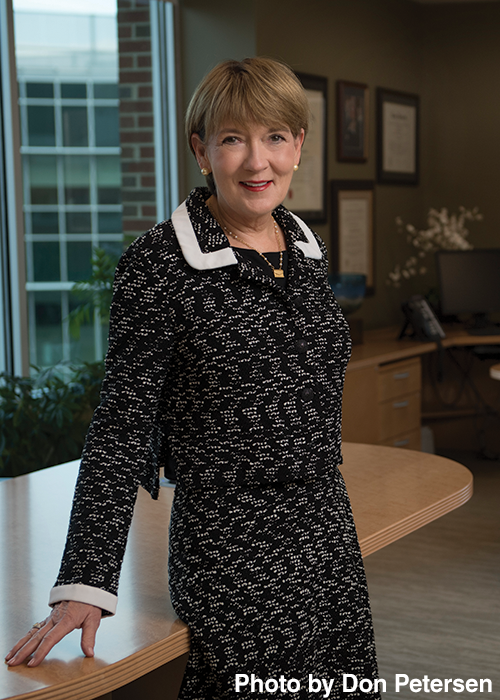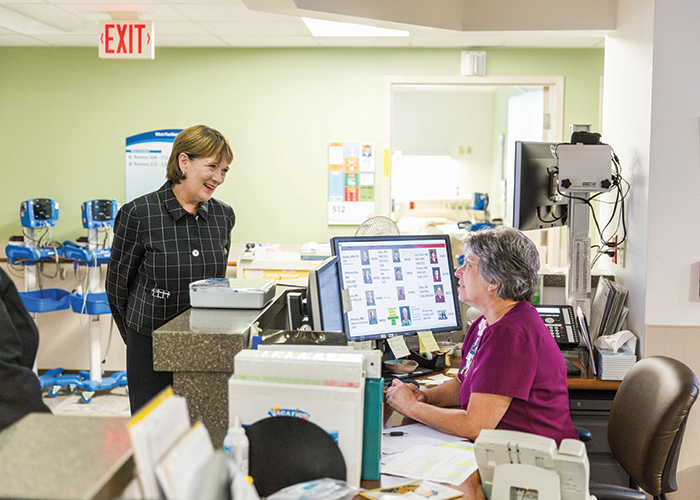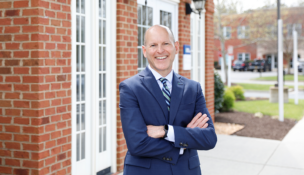Servant leadership
Carilion executive hasn’t forgotten her time on the front lines of patient care
Tim Thornton //December 1, 2017//
Servant leadership
Carilion executive hasn’t forgotten her time on the front lines of patient care
Tim Thornton //December 1, 2017//
 Virginia
Virginia
Business
Person
of the Year
Nancy Agee
President and CEO
Carilion Clinic
Roanoke
Somewhere, Nancy Agee says, there’s a photograph of her as a 5-year-old on Christmas morning, holding her new puppy while wearing her first nurse’s cap. The photo captures the beginning of Agee’s interest in a medical career.
“That poor puppy got bandaged and poked,” says the president and CEO of Carilion Clinic, a nonprofit regional health system. “He was very tolerant.”
As a teenager, Agee was a patient. She had five knee surgeries. Early on, she was told the problem was cancer and doctors would have to amputate her leg. Luckily, it wasn’t cancer and she kept her leg. The nurses and doctors who took care of Agee came to mean a lot to her. “I wanted to be like them,” she says.
Agee became a nurse, then an administrator and later a health-care executive. She was named Carilion’s chief operating officer a little more than a decade ago when it began transforming itself from a hospital network into a physician-led clinic.
Agee became president and CEO in 2011. Based in Roanoke, Carilion serves Southwest Virginia’s roughly 1 million people at more than 200 patient-care sites, including seven hospitals. The largest private employer in western Virginia, Carilion has 13,000 employees, including almost 700 doctors, Last year, the health system generated $1.7 billion in revenue.
In addition to providing health care, Carilion has become an economic driver under Agee, collaborating with Virginia Tech on the creation of a medical school and research institute. The facilities are the anchors of an evolving “innovation district” that is attracting highly skilled professionals to Roanoke.
Next year, Agee will become chairwoman of the American Hospital Association board of trustees at a time when national policy on the direction of health care remains in doubt.
In recognition of her influence in so many areas, Virginia Business has named Agee its Virginia Business Person of the Year for 2017.
Joyce Waugh, president and CEO of the Roanoke Regional Chamber, says Agee’s leadership style “is servant leadership. It means that you’re open to and truly see yourself helping others, not only to get their jobs done, but helping the community to get to the next level it needs to get to.”
Finding a new model
“I think I just grew restless,” Agee says in explaining her evolution from nurse to CEO. “I wanted to effect more change than I could see one-on-one, and so I started volunteering for other kinds of things that led to management and promotions, and that’s sort of the story.”
That’s a very short version of the story, one that leaves out a lot of experience, a lot of work.
Agee was born in 1952 in Crippled Children’s Hospital, a name Roanoke’s hospital bore for a few years during the height of Southwest Virginia’s polio epidemic. Her brother was born in the same building two years later, but by then it was called Roanoke Memorial Hospital.
“Which I think is a great story,” Agee says, “because what I love about Carilion is that it’s changed to meet the needs of those that we serve. It’s a very dynamic organization.”
Carilion rarely has been more dynamic than it was 11 years ago when it began to move toward the clinic model.
“The economic ecosystem was changing,” Agee says. “It is still changing. This was previous to Obamacare, but Obamacare didn’t just happen overnight, right?
“So, there was swirling all across the country this catalyst for change … We were doing fine, but I think incumbent on leaders is to look for the future … We’re here and we’re doing well, but what’s happening in the world and can we stay where we are? So, we began to explore options.”
Those options ranged from changing nothing at Carilion to transforming it into a for-profit corporation. The Carilion board decided it wanted to keep a lot of what the organization was at the time — a Roanoke-based nonprofit health system that was involved in medical education. The board members, however, also wanted change. They wanted to find a model that could carry Carilion into the future. “With that construct,” Agee says, “we began to look at what seems to be successful.”
The board turned what U.S. News & World Report called “a struggling cluster of traditional hospitals and clinics” into a physician-managed clinical model that puts doctors in charge. “They’re the ones that write the orders,” she says, “so they really needed to be much more integral into the delivery of care, to the decisions related to that. So physician leadership was very important.”
Leading Carilion through the transition was Agee’s predecessor, Dr. Edward G. Murphy, who died in October at age 61. Murphy, who spent a decade as Carilion’s leader, was instrumental, along with then-Virginia Tech President Charles Steger, in the creation of the Virginia Tech Carilion School of Medicine and Research Center beginning in 2007.
While development of the medical school was universally praised, not everyone was on board with the clinic model at the beginning. Some physicians rebelled, refusing to work with Carilion under its new organization.
Many of those dissenters have now changed their minds. Agee says the physicians’ support was greater than it seemed. “We had a lot of physician support,” she says. “So, even though there was this swelling concern, we actually had a lot of physician support for ‘Let’s do something different.’”
Patient care vs. rules

“I think that, having come up from the clinical side, I understand to some extent how hard it is to actually meet a patient’s needs, and so I do think that informs me,” she says. “I didn’t come up from the business side. I didn’t come up from the financial side. I actually know what it’s like to sit at the bedside of a patient. I can speak that language, and I do think that informs my decisions and it helps me be better at my job.”
Agee learned early on that rules can get in the way of patient care. She remembers a patient who hadn’t eaten all day and wanted something at 10 p.m. The kitchen was closed. There was no way to get food at the hospital, and Agee wasn’t allowed to leave the building. She left anyway, going to a grocery store to get the patient some pudding. Despite the fact she was helping a patient, Agee got a “dressing down” from her supervisor.
“There were so many rules then,” she says. “It was just this whole milieu of rules that didn’t make sense for the actual patient care. That was one of the things that affected me. How could I effect a change in that regard?”
Agee remembers a cancer patient who was in and out of the hospital so often he was a favorite with the staff. Agee came to work on a Christmas morning with presents and flowers for the patients her nursing team was serving. She had yellow roses for everyone except that cancer patient. He was getting a red one. She was so excited to tell the other nurses about the gifts and her plans to slip them into rooms before patients woke up, she didn’t notice the empty room across the hall. The popular patient had died during the night.
Agee says it was hard to lead her staff when they were grieving. It was difficult “to accept their love and compassion and teamwork for me and to be the professional caring staff we needed to be on Christmas morning for the rest of our patients.”
It was hard, but they did it. “It was really teamwork at its best,” Agee says. “That’s something I always remember, too, how much stronger we are as a team, even in the hard times — maybe especially in the hard times.”
Medical school, research institute
Teamwork is at the center of the medical school Carilion and Virginia Tech created with the help and support of local and state government. Aspiring doctors at Virginia Tech Carilion School of Medicine train with students from Carilion’s Jefferson College of Health Sciences, which offers degree programs in various fields including nursing and health-care administration. The medical school graduated its first class in 2014. More than 5,000 applicants competed for 42 slots in the class that entered the school this fall.
The Virginia Tech Carilion Research Institute, meanwhile, has attracted $80 million in federal funding. In October, the institute broke ground on a new $67 million, 105,000-square-foot building, which will allow the institute to nearly double its number of research teams to 51. Those teams are working on research that’s advancing medical knowledge and creating bioscience spinoff companies.
Carilion is stimulating the local economy in new ways. “Where we are right now was a brown field in a flood plain,” Agee says in her corner office that’s steps away from the medical school. “It’s now a thriving medical research and education complex. Across the street was an old silo and a flood plain. It’s now a fully occupied apartment building.”
Restaurants, stores, a coffee shop, an outdoor performance venue and a kayak launch on the Roanoke River have sprung up near those apartments. A few blocks away, Carilion has turned a former grocery store into an institute for orthopedics and neurosciences. “We took an abandoned building and made an amazing, thriving, gorgeous place,” Agee says. New businesses are springing up near there, too.
Carilion Roanoke Memorial Hospital anchors one end of the newly designated Roanoke Innovation Corridor. It stretches to downtown Roanoke, the Virginia Tech Carilion health sciences and technology campus, past the Jefferson College of Health Sciences to the former Gill Memorial Hospital, now a business accelerator.

So far, she says, things are going even better than she’d expected. “I think this is more than we even envisioned. I think we had good vision and execution, but, happily, it’s come together better than the traditional sum of its parts.”
It has the potential to be even better. Agee sees the 10 four-year colleges and three medical schools that are less than 60 miles from her office as under-utilized assets. “We kind of forget that in our region we have more college-aged people than anywhere else in the state. So there is a vibrancy here that I don’t think we’ve harnessed well, and I see that as part of the future as well,” Agee says. “I think that’s incredibly exciting.”
Carilion and Virginia Tech also work to build the regional economy through tools such as the VTC Innovation Fund. Created in February, the fund has $15 million to invest in what it calls “life sciences and disruptive technology opportunities” that are within 150 miles of Roanoke or that have a strong connection to Virginia Tech or Carilion Clinic.
Agee says she and Virginia Tech President Tim Sands share a vision. “We understand that the economic ecosystem is important to both of us,” Agee says.
Being the region’s largest employer carries responsibilities. “It makes us accountable to a wide region in Virginia,” Agee says. “It’s a responsibility we feel every day. It makes us understand that we do need to grow the region in order for us to continue to provide the kinds of clinical expertise and sophistication and primary care and access to care in an affordable way that we think people want and we want to be responsive to that.”
New role for hospitals?
Things aren’t so upbeat in all of Carilion’s coverage area. Its hospital in Tazewell County is losing money. It’s a small facility. With only 56 beds, it’s not even the largest hospital in Tazewell County. Tazewell’s unemployment rate in September was 5.5 percent. Neighboring Buchanan and Dickenson counties were at 6.9 and 6.5 percent, respectively. Virginia’s unemployment was 3.7 percent that month.
That part of Virginia’s economy is changing as coal — which has lost tens of thousands of jobs to automation, energy market forces and environmental regulation — fades. Medicaid expansion helped rural hospitals in some depressed areas across the country, but Virginia didn’t expand Medicaid under Obamacare. So, that’s a lifeline Southwest Virginia doesn’t have.
“I think the next frontier has to be Southwest Virginia and how to do things differently,” Agee says. “It’s clear we can’t keep doing the same things economically that worked in the past … It is tough in Southwest Virginia. I think there’s more attention being paid to that than in a long time. I think it will bear fruit in time.”
In the meantime, Carilion is changing its focus in Tazewell to more primary care. It’s also contracted with the U.S. Department of Veterans Affairs to serve veterans in the area. Rural hospitals are likely to change a great deal, Agee says.
“I think our utility and dependence of hospitals, especially small hospitals, will decline,” she says. “I don’t think that’s a bad thing. I think we can provide really good care in new ways. The whole idea of technology is exploding … I think that’s going to change the way we do things. I think settings like urgent care, where you don’t need a whole hospital, are going to be the wave of the future.
“I think we’ve got to find more sophisticated, perhaps technological, ways to deliver care that’s less dependent on hospitals. That said, hospitals are important to the economy. Hospital care is still really important.”
And things may not be as dire as some portray them. “Even with all the conversation,” Agee says, “only two hospitals have closed in Southwest Virginia.”
Grandmother’s example
As a woman rising over a four-decade career through an organization and industry dominated by men, it’s almost a given that Agee faced challenges because she doesn’t a have Y chromosome. Mentioning the old line about Ginger Rogers doing everything as well as Fred Astaire, only backwards in high heels, Agee says, “Certainly in my business there’s been some gender bias.”
One source of Agee’s resilience was another strong woman. “I had a grandmother who I lived with as a young child, and she was widowed and went to work,” Agee says. “She made sure I knew who I was and was well-grounded. If I didn’t I could get a little swat on the behind. But she also told me in her own words, you need to do more. There was an expectation. You need to do more. You can and you should, so there was no question about will.”
Jeanne Armentrout, Carilion’s executive vice president and chief administrative officer, has been with Carilion for 35 years. Armentrout says Agee “surrounded herself with mentors” as she rose, then “she really gave that gift on to others,” including Armentrout.
Armentrout remembers when she was about to give her first presentation to Carilion’s board. Since she’d done this sort of thing many times before for other groups, “I thought I was prepared,” Armentrout says. Agee nudged her to prepare even more. This was a performance at a new level, a higher level, and it carried higher expectations. Armentrout practiced and refined her presentation. It was better because of Agee’s intervention. “She’s got that quiet, calm, thoughtful demeanor,” Armentrout says. “That’s where your power is.”
William Jacobsen, administrator at Carilion Franklin Memorial Hospital, had been out of health care for years, doing mission work in Asia, when he interviewed with Agee and her predecessor, Ed Murphy. Jacobsen decided to join Carilion because he felt the organization was doing the right things. Its focus was about the patients.
“Ed was a great visionary,” Jacobsen says. “Nancy had the stuff to make it happen.”
g















